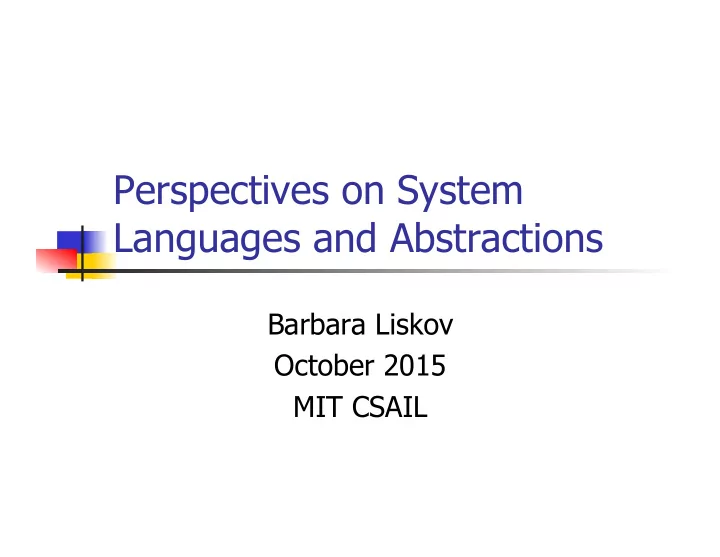

Perspectives on System Languages and Abstractions Barbara Liskov October 2015 MIT CSAIL
Abstractions for Structuring Systems The early days Single machine systems Distributed systems
Single Machine Systems In the beginning: batch processing So: Multiprogramming Time sharing
“THE” E. W. Dijkstra, The structure of the “THE”- Multiprogramming system CACM 68, SOSP 67, and EWD 196 Strictly layered Independent users
Layer 0 Processes and semaphores P and V operations Used for Critical sections IPC (“private” semaphores) No “deadly embrace”
Venus B. Liskov, The design of the Venus operating system CACM 72 and SOSP 71 A time-sharing system Processes and semaphores in microcode
The Structure of Venus Resources presented through “layers of abstraction” Multiple operations Hidden state and resources Calls ran in process of caller E.g., a printer requestor
Two System Models Resources managed by resource processes With IPC Resources managed by user processes With abstract data types (ADTs) and procedure calls
These Models are Duals Lauer and Needham, On the duality of operating system structures, Proc. 2 nd International symp. on operating systems, 78 and SIGOPS Review 79 E.g., port == operation
Programming Issues Resource process multiplexing User process synchronization monitors C. A. R. Hoare, CACM 74, Monitors: an operating system structuring concept
Monitors ADT with associated lock acquired automatically Plus condition variables Wait c releases the monitor lock Signal c passes the lock
Monitors in Mesa Lampson and Redell, Experience with processes and monitors in Mesa CACM 80 and SOSP 79 Issues: Nested monitor problem “external” operations
Programming Languages Modula and later variants Concurrent Pascal Mesa
Distributed Systems Motivation Sharing on a LAN The dream of distributed computing But: how to structure? Clients and servers? Distributed heap?
Communication is Required Communication is hard “ … construction of communicating programs was a difficult task, undertaken only by members of a select group of communication experts.” (B&N, Implementing remote procedure calls, TOCS 84)
Communication Issues Linking requests with replies Format of messages Heterogeneity vs. homogeneity Location independence Local vs. remote Finding/selecting remote servers
Remote Procedure Calls B. J. Nelson, Remote procedure call Xerox Parc TR CSL-81-9 Birrell and Nelson, Implementing remote procedure calls TOCS 84 and SOSP 83
RPC Motivation It’s clean and simple and general Local and remote calls look the same Issues in request/reply are similar
RPC (B&N, TOCS 84)
Doing More Replica Client Viewstamp Viewstamp Application Application Replication Replication operation operation result result
RPC Issues Inherent expense
RPC Issues Call/reply too constraining Liskov and Shrira, Promises: Linguistic support for efficient asynchronous procedure calls in distributed systems, PLDI 88 Gifford and Glasser, Remote pipes and procedures for efficient distributed communication, TOCS 88
RPC Issues Semantics Exactly once if reply (B&N 84) Exactly once (Liskov and Scheifler, Guardians and actions: Linguistic support for robust, distributed programs, TOCS 83)
What Next? Perhaps we need new abstractions? Client/server with extended RPC? Perhaps we should be doing more language design?
Perspectives on System Languages and Abstractions Barbara Liskov October 2015 MIT CSAIL
Recommend
More recommend